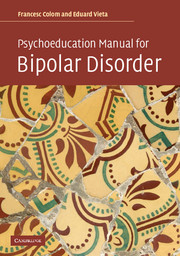Book contents
- Frontmatter
- Contents
- Foreword
- Preface
- Part 1 Clinical, diagnostic, and therapeutic aspects of bipolar disorders
- Part 2 Concept and methodology of psychoeducation
- Part 3 Psychoeducation program: sessions and contents
- Unit 1 Awareness of the disorder
- Session 1 Presentation and rules of the group
- Session 2 What is bipolar disorder?
- Session 3 Etiological and triggering factors
- Session 4 Symptoms I:Mania and hypomania
- Session 5 Symptoms II: Depression and mixed episodes
- Session 6 Evolution and prognosis
- Unit 2 Drug adherence
- Session 7 Treatment I: Mood stabilizers
- Session 8 Treatment II: Antimanic drugs
- Session 9 Treatment III: Antidepressants
- Session 10 Plasma levels of mood stabilizers
- Session 11 Pregnancy and genetic counseling
- Session 12 Psycho-pharmacology vs. alternative therapies
- Session 13 Risks associated with treatment withdrawal
- Unit 3 Avoiding substance abuse
- Session 14 Psychoactive substances: risks in bipolar disorders
- Unit 4 Early detection of new episodes
- Session 15 Early detection of mania and hypomanic episodes
- Session 16 Early detection of depressive and mixed episodes
- Session 17 What to do when a new phase is detected?
- Unit 5 Regular habits and stress management
- Session 18 Regularity of habits
- Session 19 Stress-control techniques
- Session 20 Problem-solving strategies
- Session 21 Closure
- Final note: Is psychoeducation efficacious?
- Bibliography
- Index
Session 21 - Closure
from Part 3 - Psychoeducation program: sessions and contents
Published online by Cambridge University Press: 06 January 2010
- Frontmatter
- Contents
- Foreword
- Preface
- Part 1 Clinical, diagnostic, and therapeutic aspects of bipolar disorders
- Part 2 Concept and methodology of psychoeducation
- Part 3 Psychoeducation program: sessions and contents
- Unit 1 Awareness of the disorder
- Session 1 Presentation and rules of the group
- Session 2 What is bipolar disorder?
- Session 3 Etiological and triggering factors
- Session 4 Symptoms I:Mania and hypomania
- Session 5 Symptoms II: Depression and mixed episodes
- Session 6 Evolution and prognosis
- Unit 2 Drug adherence
- Session 7 Treatment I: Mood stabilizers
- Session 8 Treatment II: Antimanic drugs
- Session 9 Treatment III: Antidepressants
- Session 10 Plasma levels of mood stabilizers
- Session 11 Pregnancy and genetic counseling
- Session 12 Psycho-pharmacology vs. alternative therapies
- Session 13 Risks associated with treatment withdrawal
- Unit 3 Avoiding substance abuse
- Session 14 Psychoactive substances: risks in bipolar disorders
- Unit 4 Early detection of new episodes
- Session 15 Early detection of mania and hypomanic episodes
- Session 16 Early detection of depressive and mixed episodes
- Session 17 What to do when a new phase is detected?
- Unit 5 Regular habits and stress management
- Session 18 Regularity of habits
- Session 19 Stress-control techniques
- Session 20 Problem-solving strategies
- Session 21 Closure
- Final note: Is psychoeducation efficacious?
- Bibliography
- Index
Summary
Goal
Session number 21 will be used to close the group properly. The experience of sharing a program for 20 weeks usually creates strong bonds between patients, and between the patients and the group as a whole, so that for them the act of closure has a strong emotional value.
Procedure
We can use the first half hour to resolve any doubts about the material from previous sessions.
The next step is to ask the group how they believe their participation in the program has changed their behavior or way of thinking with respect to various areas:
– Awareness of the disorder.
– Need for treatment.
– Detection of symptoms.
– Suicidal thinking.
– How to explain the disorder to friends and acquaintances.
– How to structure time.
– Taking toxic substances.
This point is especially important because, on the one hand, it allows us to make some kind of evaluation of the subjective benefit to our patients, and on the other hand it allows us to establish some content.
The next step is to ask the patients to evaluate the program. This can be done as follows:
Session 21
“Between the time we started this type of program 10-years ago and the present, we think we have done a great deal to improve its quality. This is largely because two of us professionals now have more experience, but even more because of the changes we have incorporated following your comments and suggestions.
- Type
- Chapter
- Information
- Psychoeducation Manual for Bipolar Disorder , pp. 197 - 200Publisher: Cambridge University PressPrint publication year: 2006

